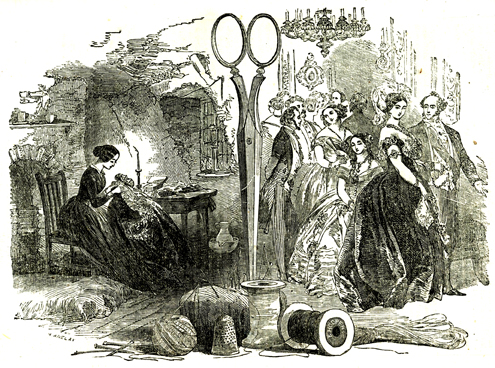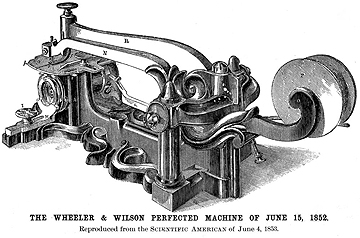FITTER & STITCHER.
(period costuming)
19th century

The Seamstress; or, the White Slave of England - 1850

I am a fitter and stitcher for hire.
What is a fitter and stitcher and what does one do? In the early and middle 19th century women made their own clothing or hired it to be done rather than going to a store to buy it. Though we are not 19th century people, there are many of us who have reason to dress by 19th century standards and fashions thereby requiring 19th century style services. So, to answer the questions, a fitter and stitcher possesses the skills and knowledge to make a pattern for a particular person and then make the garment for that person from that pattern. This is obviously a big simplification of all that is entailed, but if you need a fitter and stitcher for your 19 century style costume, you have found one!
Actually, in the hierarchy of dressmakers, a fitter and stitcher is somewhere in the obscure middle of the ranks. The higher ranks of the trade were dress-maker madams who no longer actually put their own hands to to any stitching tasks, but presided over slave-like women and girls who put themselves (or were put by parents) into such a situation rather than they lose their character in other slave-like trades for females. Thus, the obvious bottom ranks were the “kept” women whose lives were literally used up for the sake of the fashion and clothing industry. The middle ranks include all the stitchers who took in work of various kinds and made a scant or reasonable income by running their own small business. Of course, such small shops were hard pressed in big cities to compete with the keepers of many stitchers. But in smaller communities, a respectable stitcher might have loyal customers who kept her busy thereby preserving her character and providing a small but sufficient income.
In a 19th century setting, a woman needing a dress would come or send a servant to the dressmaker's establishment, which looked not unlike a house with a foyer and a parlor apparent to the visitor. Thus dressmaker and client would meet at the "shop" or at the client's home, having what would appear to be "a tea party." However the conversation would include the kind of dress needed and maybe the color or other particulars. The dressmaker might send an employee back to the client's home to take her measurements. If the woman had been to that dressmaker before, the measurements might not even be necessary, having the woman's measurements recorded or her patterns "on file." Probably within a few days or a week, as needed, the dress would be delivered to the client and payment made for it.
So it was, and so it is, at least for this fitter and stitcher. The following pages will help you decide if you would like to pursue engaging me for a stitching task for you. The last section pertains to the care of your garments. I hope you find the information useful.


Decisions, Decisions: Fabric and Pattern Selections
There are two ways we can make the decisions about the fabric or patterns to be used. One is that you make these decisions and bring the fabric and pattern to me when we meet to discuss the job. The other way is that we discuss the end result you want and we decide together how to achieve it. Fortunately, there are local sources for great period fabrics. I would be glad to accompany you to such establishments to make fabric choices.
There are some fabrics I will not use/work with. There are some patterns that are literally not sew-able and I know better than to try (and the price you paid for either is not an indicator of it's worth or usefulness). Therefore, if you have chosen the fabric and pattern prior to our meeting, there is a chance that your selections will be the reason I will decline to be engaged. It may be that I will assess the situation and offer to do the job with an extra fee. I also like to choose the lining fabrics that I use.
I advise purchasing an extra 1/2 - 1 yard of fashion fabric when possible.
Prewash and iron your washable dress fabric and cotton linings. If you'd like me to do this for you, add a charge of $10. You must request in writing that I wash/iron for you, thereby absolving me from any responsibility for the washability of your fabric. If you want the fabric to be used without prewashing, please also make this request in writing, thereby absolving me from any responsibility for the washability of your finished garment. This does not apply to silks and woolens, though these fabrics may be subject to extra fees (especially silks prone to raveled edges).
Fees
Please refer to the information below to help you calculate the possible fees. I offer many years of stitching experience which is not reflected in my $10 per hour wage (with any other occupation, 35 years of experience comes at $35 per hour!). It may surprise you, however, how many hours are represented by a single completed garment. Hence, the 19th century garment owner, except the very wealthy, was inclined to take care of their garments even passing them along as inheritance to the next generation. Be sure to read the section I provide regarding the wear, cleaning, and care of your garment.
Cutting
Anything sewn by me will be cut by me. It is not helpful nor will it be a savings to the client to have the garment cut out before engaging me as the stitcher. On the contrary, an "inconvenience fee" will be added (or the job may be declined).
Estimate 1 to 3 hours to cut the fabric for a garment.
Stitching
6-15 hours (or more depending on style and fabrics) to sew a pair of trousers, a corded petticoat, a period dress (10 hours minimum), a man's shirt, a corset, a coat.
3-6 hours to sew a chemise, a pair of drawers, a simple petticoat.
Mid-19th Century Dresses
Prices pertain to: working with good quality cotton dress fabric (specialty fabrics such as silk or difficult-to-match fabric designs may incur an extra fee); "double fabric" lined bodice; hand-stitched facings; machine-stitched seams, hem, and button holes; skirt gathered to bodice (not pleated, cartridge or otherwise); button placement marked.
"Extra Fees" may pertain to: fabrics other than cottons, difficult to match designs, fashion extras (such as, but not limited to, bodice, sleeve, or skirt variations), fit issues (see Fittings), trims (which often require hand-stitching), and original designs.
Fittings
Patterns are made to "fit" the woman few of us are! No matter what size you are, your body is a little more here or a little less there than the pattern size nearest your shape. Mid-19th century bodices were to fit like a glove over body-shaping undergarments. To look the part, you really need to dress the part from the skin outward. This said, if you don't have period undergarments, you really need to start there before investing in outward fashion pieces. Once you have procured your chemise, drawers, corset, and various petticoats and/or hoops, you are ready to be fitted for a something to wear that the public can see.
The main part of the garment to "fit" is the bodice. The end result of "bodice fitting" is an individualized basic bodice pattern which serves as the basis for the design of the finished bodice. Separate fittings are required for variations in style or period (i.e. 1850's Isabella bodice vs. 1880's day dress bodice vs. any period ball gown bodice).
The usual fitting routine goes like this.
Using measurements, a bodice mock-up (practice bodice of "junk" fabric) is made in the most reasonable size. The bodice is tried on the client and the fitter makes notes of adjustments to be made. A personalized pattern is developed by the fitter and a new mock-up is made and fitted. If this is a good fit, the fitter may progress to making the dress bodice. If adjustments are needed, a new personalized pattern is made to reflect the adjustments, and possibly a new mock-up is made to be sure the fit is good before proceeding to the actual dress-making.
This process, referenced as "fitting" carries a fee of $25 to $50 depending on the styles and figure complications. Once done, a variety of bodices can be made from the pattern provided the style variations are in the same costume period and of similar basic shape (i.e. variety of day dresses, not a ball gown). The pattern is kept "on file" and the fee is not repeated for a similar bodice, thus saving the fitting charge for subsequent dresses (as long as the body doesn't change too much).
Garment Care
To make the most of your investment, take care of your clothes. I offer the following sage suggestions in your own interest.
~ Start with a clean body. It preserves your fabric.
~ Wear undergarments that keep your skin (and your body oils) off the fabric.
~ Wash (washable) garments in mild soaps (not detergents) turning the garments inside-out. This preserves color and patina.
~ Never use bleach, even on whites. Bleach "eats" fabric. Don't use it. There are non-chlorine products that you can try with caution, but don't use bleach.
~ Smooth seams gently and hang your garments dry indoors. Listen to me: Driers kill clothes! Your garments will retain their "body" and colors ever so much longer if you never put them in the clothes drier (no matter the setting).
~ Never hang your clothes to dry in the sun. The drier is bad and sunlight is worse. The damage may not show up immediately, but it will be done and it will show up. Your clothing gets all the sunlight it can stand when you wear the garments.
~ Know your buttons. Some can be washed and some can't. I only use buttons that can be washed, but if you use your own finds, be sure of their wash-ability or be prepared to replace them. Buttons were valued and removed before garments discarded in the 1800s.


D. Øydegaard,
Fine and Dandy Fitter and Stitcher,
(209)536-1859

This page is created for the benefit of the public by
Email contact:
Type into your email dannie with the ampersat (@), also called the "at sign",
then gazette with a peiod (.) and add com
Sorry to have to make it so hard but it is necessary to stop the spammers.....
A WORK IN PROGRESS.
© Fine & Dandy - Floyd D. P. Øydegaard.







